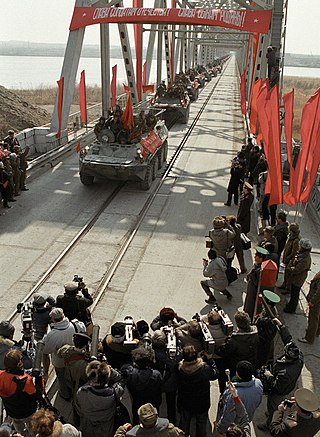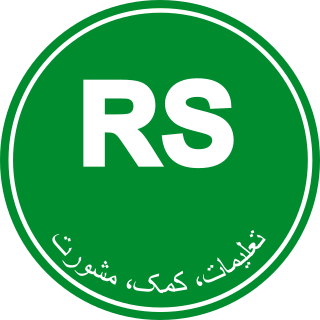The United States has conducted two withdrawals of United States troops from Afghanistan:

Mohammad Najibullah Ahmadzai, commonly known as Dr. Najib, was an Afghan politician who served as the General Secretary of the People's Democratic Party of Afghanistan, the leader of the one-party ruling Republic of Afghanistan from 1986 to 1992 and as well as the President of Afghanistan from 1987 until his resignation in April 1992, shortly after which the mujahideen took over Kabul. After a failed attempt to flee to India, Najibullah remained in Kabul. He lived in the United Nations headquarters until his assassination during the Taliban's capture of Kabul.

Bagram Airfield-BAF, also known as Bagram Air Base, is located 11 kilometres (6.8 mi) southeast of Charikar in the Parwan Province of Afghanistan. It is under the Afghan Ministry of Defense. Sitting on the site of the ancient Bagram at an elevation of 4,895 feet (1,492 m) above sea level, the air base has two concrete runways. The main one measures 11,819 by 151 feet, capable of handling large military aircraft, including the Lockheed Martin C-5 Galaxy. The second runway measures 9,687 by 85 feet. The air base also has at least three large hangars, a control tower, numerous support buildings, and various housing areas. There are also more than 13 hectares of ramp space and five aircraft dispersal areas, with over 110 revetments.
The following lists events that happened during 1986 in Afghanistan.

The proposed invasion of Afghanistan prompted protests with mass demonstrations in the days leading up to the official launch of the war on October 7, 2001. The continuation of the war in Afghanistan from 2001 to 2021 lead to further protest and opposition to hostilities.
Opposition to the War in Afghanistan (2001–2021) stemmed from numerous factors, including the view that the United States invasion of Afghanistan was illegal under international law and constituted an unjustified aggression, the view that the continued military presence constituted a foreign military occupation, the view that the war did little to prevent terrorism but increased its likelihood, and views on the involvement of geo-political and corporate interests. Also giving rise to opposition to the war were civilian casualties, the cost to taxpayers, and the length of the war to date.

Relations between Afghanistan and the United States began in 1921 under the leaderships of King Amanullah Khan and President Warren G. Harding, respectively. The first contact between the two nations occurred further back in the 1830s when the first recorded person from the United States explored Afghanistan. The United States government foreign aid program provided about $500 million in aid for economic development; the aid ended before the 1978 Saur Revolution. The Soviet invasion of Afghanistan in 1979 was a turning point in the Cold War, when the United States started to financially support the Afghan resistance. The country, under both the Carter and Reagan administrations committed $3 billion dollars in financial and diplomatic support to the anti-Soviet Mujahideen forces. Beginning in 1980, the United States began admitting thousands of Afghan refugees for resettlement, and provided money and weapons to the Mujahideen through Pakistan's Inter-Services Intelligence (ISI). The USSR withdrew its troops in 1989.

See the article Afghanistan War order of battle for the disposition of coalition forces in Afghanistan in 2012.

The final and complete withdrawal of the Soviet 40th Army from Afghanistan began on 15 May 1988 and ended on 15 February 1989, under the leadership of Colonel-General Boris Gromov. The Soviet military had been one of the main combatants in the Soviet–Afghan War since its beginning in 1979.
The sixth emergency special session of the United Nations General Assembly was held between 10 and 14 January 1980 to consider the situation in Afghanistan. As the Soviet–Afghan War began members of the United Nations General Assembly requested the Security Council consider the situation. The USSR veto of a resolution led the other members to invoke the 'Uniting for Peace' resolution to defer the issue to the General Assembly in an emergency special session. It was the sixth emergency special session since the 'Uniting for Peace' resolution was adopted in 1950. The session was dominated by questions of its legitimacy since the Afghanistan government had invited the Soviet intervention in their civil war. Led by the non-aligned members, the session ended with a resolution from the General Assembly calling for the immediate, unconditional and total withdrawal of foreign troops from Afghanistan and the cessation of all outside intervention, subversion, coercion or constraint, of any kind whatsoever, so that its people could freely choose its own economic, political and social systems.
A 47-nation global survey of public opinion conducted in June 2007 by the Pew Global Attitudes Project found considerable opposition to the NATO military operations in Afghanistan. In 2 out of the 47 countries was there a majority that favoured keeping troops in Afghanistan – Israel (59%) and Kenya (60%). On the other hand, in 41 of the 47 countries pluralities wanted NATO troops out of Afghanistan as soon as possible. In 32 out of 47 countries majorities wanted NATO troops out of Afghanistan as soon as possible. Majorities in 7 out of 12 NATO member countries wanted troops withdrawn as soon as possible.

The Afghan conflict, also called the Afghan crisis or Instability in Afghanistan, is a series of events and wars that have kept Afghanistan in a near-continuous state of armed conflict since the 1970s. The country's instability began after the collapse of the Kingdom of Afghanistan in the 1973 coup d'état; with the overthrow of Afghan monarch Mohammad Zahir Shah, who had reigned for almost forty years, Afghanistan’s relatively peaceful period in modern history came to an end. The triggering event for the first major war in Afghanistan during this period was the Saur Revolution of 1978, which overthrew the Republic of Afghanistan and established the Democratic Republic of Afghanistan. Rampant post-revolution fighting across the country ultimately led to a pro-government military intervention by the Soviet Union, sparking the Soviet–Afghan War in the 1980s.

The U.S.–Afghanistan Strategic Partnership Agreement (SASPA), officially titled Enduring Strategic Partnership Agreement between the Islamic Republic of Afghanistan and the United States of America, was an agreement between the former government of Afghanistan and the United States of America that provides the long-term framework for the relationship between Afghanistan and the United States of America after the drawdown of U.S. forces in the Afghanistan war. SASPA went into effect on 4 July 2012, as stated by U.S. Secretary of State Hillary Clinton, who said on 8 July 2012, at the Tokyo Conference on Afghanistan: "Like a number of countries represented here, the United States and Afghanistan signed a Strategic Partnership Agreement that went into effect four days ago." SASPA was broadened by the Bilateral Security Agreement (BSA) that both countries were obliged to negotiate within one year, which resulted on 30 September 2014 in the "Security and defense cooperation agreement between the Islamic Republic of Afghanistan and the United States of America" (SADCA).

The withdrawal of United States troops from Afghanistan describes the drawdown of United States Armed Forces in the Afghanistan war and the plans after its post-2014 presence when most combat troops had left Afghanistan at the end of 2014.

Resolute Support Mission (RSM) or Operation Resolute Support was a NATO-led multinational mission in Afghanistan. It began on 1 January 2015 as the successor to the International Security Assistance Force (ISAF), which was completed on 28 December 2014. Pursuant to United Nations Security Council Resolution 2189 of 2014, RSM was a noncombat mission aimed at advising and training Afghan security forces to provide long-term security to the country, under the aegis of the Security and Defence Cooperation Agreement BSA between the United States and Afghanistan, which was originally supposed to run from 1 January 2015 and "shall remain in force until the end of 2024 and beyond" unless terminated with two years' advance notice.
This article summarizes the history of the War in Afghanistan (2001–2021).

In December 2019, Iraq and the United States began discussing the partial withdrawal of American combat troops from Iraq. In January 2020, during massive protests and following an escalation of tensions between the United States and Iran, the Iraqi Council of Representatives passed a non-binding measure to "expel all foreign troops from their country," including American and Iranian troops. Following the vote, U.S. President Donald Trump initially refused to withdraw from Iraq, but began withdrawing forces in March.

The United States Armed Forces completed their withdrawal from Afghanistan on 30 August 2021, marking the end of the 2001–2021 war. In February 2020, the Trump administration and the Taliban, without the participation of the then Afghan government, signed the US–Taliban deal in Doha, Qatar, which stipulated fighting restrictions for both the US and the Taliban, and provided for the withdrawal of all NATO forces from Afghanistan in return for the Taliban's counter-terrorism commitments. The Trump administration's US–Taliban deal, and then the Biden administration's decision in April 2021 to pull out all US troops by September 2021 without leaving a residual force, were the two critical events that triggered the start of the collapse of the Afghan National Security Forces (ANSF). Following the deal, the US dramatically reduced the number of air attacks and deprived the ANSF of a critical edge in fighting the Taliban insurgency, leading to the Taliban takeover of Kabul on 15 August 2021.

The Agreement for Bringing Peace to Afghanistan, commonly known as the US–Taliban deal or the Doha Accord, was a peace agreement signed by the United States and the Taliban on 29 February 2020 in Doha, Qatar, to bring an end to the 2001–2021 war in Afghanistan. Negotiated by Zalmay Khalilzad, the agreement did not involve the then Afghan government. The deal, which also had secret annexes, was one of the critical events that caused the collapse of the Afghan National Security Forces. Adhering to the conditions of the deal, the US dramatically reduced the number of US air raids, leaving the ANSF without a key advantage in keeping the Taliban at bay. This resulted in 'a sense of abandonment within the ANSF and the Afghan population'. ANSF was ill-prepared to sustain security following a US withdrawal, which allowed for the Taliban insurgency, ultimately leading to the Taliban takeover of Kabul on 15 August 2021.
Afghanistan withdrawal may refer to: